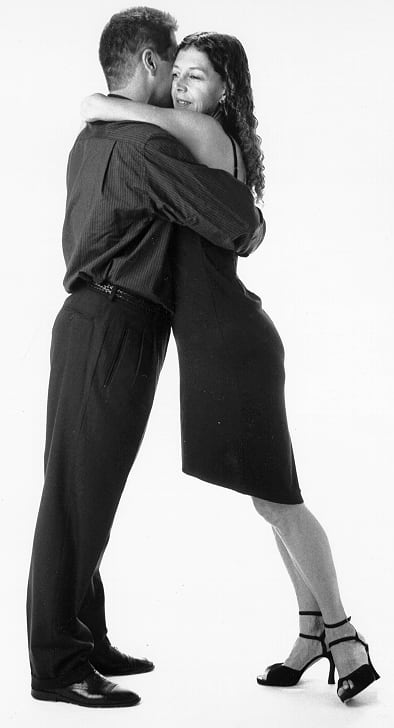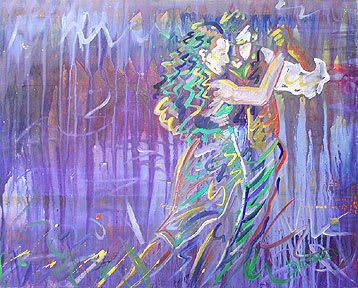http://yangningyuan.blogspot.jp/2011/11/tango-embrace.html
より
Tango can be danced in many different ways.
タンゴは多くの異なる方法で踊ることができます。
For example, it can be danced in a virtual embrace where the two partners dance around each other without any physical contact.
たとえば、タンゴは踊ることができます2人のパートナーは、少しも物理的な接触なしにお互いの周りを踊る仮想抱擁で。
The man leads the woman by sending a visual signal from his torso
男は女性をリードする彼の胴体から視覚信号を送信することによって
, showing her how he wants her to move
彼女に示す動く方法を
, and the woman follows the visual lead to make the movement.
そして 女性はフォローする動きをつくる視覚的なリードを
A visual lead is difficult to perceive because it cannot be felt and must be seen.
視覚的なリードは認識することは困難であるなぜならそれを感じることができないそして見なければならないため。
The difference between different signals often is so subtle that it is hard to discern.
異なるシグナル間の差は、しばしば、それが識別するのは難しいように微妙です。
It is quite challenging for the leader to send a clear visual signal and for the follower to apprehend it.
それはかなり困難ですリダーが明確に視覚的シグナルを送り、そしてフォロワーがそれを理解するために。
Also, a virtual embrace lacks the physicality, comfort and sensation of a physical embrace.
また、仮想抱擁は身体、快適さと物理的な抱擁の感覚を欠いている。
It disables movements that require physical support.
それは物理的なサポートを必要とする動きを無力にします。
Despite these limits
これらの制限にもかかわらず
, virtual embrace reveals the fact that lead/follow is not just a physical process but also a psychological one
仮想の抱擁は事実を明らかにする。リード/フォローは物理的なプロセスだけでなく心理的なップロセスである
, which requires mental concentration and perception.
そしてそれは精神集中や知覚を必要とする
カンマが
・有る→非制限用法(継続用法)
・無い→制限用法(限定用法)
と、用法が違い、
非制限用法は、接続詞と代名詞を補って訳します。
I have a dog , which has a black tail.
=I have a dog and it has a black tail.
私は一匹の犬を飼っています。そしてそれは黒い尻尾を持っています。
→犬は一匹しか居ない。
I have a dog which has a black tail.
私は、黒い尻尾を持った、一匹の犬を飼っている。
→違う色の尻尾を持った犬が、他に居るかも知れない。
The awareness of this fact is important
because one cannot dance well with feet unless one can dance with heart.
この事実の認識が重要である
なぜなら一心で踊ることができない限り、足でよく踊ることができない。
Tango can also be danced in an open embrace where the two partners are connected only by arms and hands without any body contact.
タンゴは、2人のパートナーがいかなる体の接触することなく、
ただ腕と手で接続されているオープンな抱擁で踊っすることができます。
ソース www.kingsoft.jp
1.We know the truth, not only by the reason, but also by the heart.
我々が真理を知るのは、理知によるだけではなく、また心情(こころ)によって知るのである。
2.He is a busy man, so you can get in touch with him only by telephone.
彼は忙しい人だから、電話でなければ彼と連絡をとれないでしょう。
3.I said so only by guess.
私はただ、当てずっぽうを言ったまでだ。
4.I know him only by name.
私は彼の名前は知っている。
5.One cannot judge people only by their outward appearances.
外見だけで人を判断することはできない。
6.Most birds can see only by day.
たいていの鳥は昼間しか目が見えない。
7.Most people judge men only by their success or their good fortune.
たいていの人は、人間をただその人の成功なり、あるいは幸運によってのみ判断する。
8.The dentist will see you only by appointment.
その歯科医には予約をしないと見てもらえない。
9.Only by prohibiting nuclear weapons altogether can we stop the arms race.
核兵器を全面的に禁止して初めて、兵器競争を止めさせることができる。
10.You can meet Dr. White only by appointment.
ホワイト博士とは前もって約束した上でなければ面会できない。
Arms and hands are extensions of the body.
腕や手は、身体の拡張である。
Even in the absence of direct body contact the dancers can still sense each other’s intentions and body movements through arm and hand contact.
でも、直接ボディコンタクトの無いとき
ダンサーはまだ腕と手の接触を通じて、互いの意図と体の動きを感知することができます。
The open embrace provides a frame of support while leaving room for body maneuvering,
オープン抱擁は、身体の駆け引きの余地を残したままサポートのフレームを提供する、
and therefore is favored by movement-oriented dancers who like fancy steps and dramatic acts.
それ故に,派手なステップと劇的なアクション志向のダンサーによって支持されています。
It is arguable, however, that open-embrace dancers still use the torso to lead and follow, as they theoretically should.
それは理論的には、オープン採用ダンサーは、まだ、リードとフォローするために胴体を使用するべき、しかし、議論の余地がある。
In reality, due to the lack of body contact, they tend to rely on arms and hands, which is less comfortable in comparison to the torso-to-torso connection of the close embrace.
現実には、ボディコンタクトの不足のために、彼らは緊密な抱擁の胴から胴の接続に比べて心地よくなじみが少ない腕や手、に依存する傾向があります。
Also, the open embrace lacks the intimacy, sensuality and soulfulness of the close embrace.
また、オープンな抱擁に親密さ、官能性と近い抱擁のソウルフルを欠いている。
Tango can also be danced only with the connection of the torsos, free from arm and hand contact.
タンゴは胴の接続のみで踊ることができます、腕と手の接触から自由に。
Dancing this way can sharpen the dancer’s ability of using the torso to communicate without the help of arms and hands.
この方法で踊ると腕と手の助けを借りずに胴体を使用してのコミュニケートするダンサーの能力を磨くことができます。
Using the torso to lead and follow is essential in tango, which is a unique feature of Argentine tango.
リードとフォローするために胴体を使用するとは不可欠である、そしてそれはアルゼンチンタンゴのユニークな特徴である。
Ballroom dancers and open-embrace dancers who are not used to torso communication particularly need this exercise.
社交ダンサーと胴体のコミュニケーションに使用していないオープン抱擁ダンサーは、特にこの練習をする必要があります。
sacadas (leg thrusts), ganchos (leg hooks), barridas (foot drags) and boleos (sweeps)





They will quickly discover how their habitual using of arms and hands impedes their dance.
彼らはすぐにを理解します常習的に腕や手の使用することがダンスを阻害することを。
They will also discover the importance of the arm and hand contact, without which, just as without the torso contact, it is difficult to dance as one seamless body.
彼らはまた腕と手の接触の重要性を発見するでしょう、それなしで、胴体接触せずに、1つのシームレスボディ(一体)として踊ることは困難である。
People do not actually dance tango only using the torso connection without the support of arms and hands, but the experience gained from this exercise will lay a solid foundation for their tango dancing, regardless of the embrace they choose.
人々は実際には腕や手のサポートなしで胴体接続を使用してタンゴを踊りませんが、この演習から得た経験により彼らはダンスのための強固な基盤を築くでしょう、選択したホールド関係なく。
experience
[ikspíəriəns]
名詞
経験, 体験(で得た知識),
熟語
regardless of ...
…にもかかわらず
embrace
[imbréis]
名詞
抱擁.;アブラッソ(タンゴの組み方)
The most communicative and comfortable embrace is the close embrace, where the two partners are connected not only by arms and hands but also by the direct contact of the torsos.
ほとんどのコミュニケーションと快適な抱擁は接続されているに近い抱擁です、そしてそれは2人のパートナーの腕と手ではなく、胴の直接接触によってである。
The body is a very expressive and receptive organ.
体は非常に表現力であり受容器官である。
It is also a very sensual and comfortable object to be held in the arms.
また、腕の中で行われる非常に官能的で快適なことです。
comfortable
[kʌmfertəbl]
[形]
1快適な, 気持ちのよい;(安)楽な, くつろいだ
object
[ɑ́bdʒiktɔ́-]
名詞
物体, もの, 対象
目的(物)
[哲学]客観, 対象
[文法]目的語
In a close embrace, the two partners lean on each other chest against chest.
緊密な抱擁では、2人のパートナーは、胸に対して互いに胸にもたれる。
Her head rests on his shoulder.
彼女の頭は彼の肩にかかっている。
His arm holds her back, and hers around his neck.
彼のうでは背中をホールドし、彼女のうでは彼の首にまわる
The two partners feel each other’s soft, springy, sensitive, flexible and responsive body, communicating through it the feelings stirred by the music while dancing, in the support of their arms around each other.
両社は互いの、ソフトな弾力、感度、柔軟性と応答性の身体を感じています
踊りながら音楽により動かされる感覚をコミュニケートし、お互いを腕でサポートしながら。
The intimacy, soulfulness, physicality and comfort of the embrace make it the favorite style for feeling-oriented dancers who incline to the romanticism, sentiment and sensuality of the dance more than the gymnastic acts.
抱擁の親密さ、ソウルフル、身体性と心地良さがさが体操の行為といよりダンスのロマン主義、感情と官能への傾斜感覚指向のダンサーの好みのスタイルにします。
incline to
[inkláin]
心が向く
feeling-oriented
感覚的に方向づけられた
intimacy
[íntiməsi]
名詞
親密
soulfulness
[名]
1魂のこもったもの
2感情のこもった物;悲しげな物
3熱情的な物
physicality
【名詞】
肉体的衝動
comfort
[kʌmfərt]
[名]
1慰め;楽しみ;安心
2慰めを与える人, 慰めとなるもの;(comforts)生活を安楽にするもの
3安楽, 気楽, 快適
favorite
[féiverit]
[名]
1お気に入り, 大好きな物,
━[形]
1お気に入りの, 大好きな
2得意の
.I feel so cold and I long for your embrace.
君なしではどうしていいかわからない。
long for
待ち焦れる;待遠しがる;熱望;懐かしがる;待ち侘びる;慕う;渇望;恋慕う;思慕;念願;待遠しい;恋しい;恋しがる
embrace
[imbréis]
他動詞
抱擁する, 抱きしめる
[法律法学](陪審員などを)抱き込む
包含する, 囲む, 取り巻く
(申出・宗教を)受け入れる
採用する, (機会を)捕える
悟る, 見て取る.
品詞の変化
自動詞
抱き合う.;
名詞
抱擁.;
embrace
[embréis]
[動](他)
1…を抱きしめる, 抱擁する
2〔思想など〕を喜んで受け入れる
3〔機会〕をとらえる
4〔意見・信仰など〕を奉じる, 採用する;〔職業〕につく, 〔生活など〕に入る
5…悟る
6…を取り巻く, 囲む
7…を含む;〔広範囲〕にわたる
━[名]
1抱擁
2(しばしばembraces)(婉曲)性交
3受け入れること
Beginners may find that close embrace hinders the movement due to the lack of space between the partners.
初心者に近い抱擁は、パートナーとの間の空間の不足のために動きを妨げることがあります。
ソース www.kingsoft.jp
due to ...
(1) …に帰すべき, …のために
(2) 口前置詞句として…のために
1.I am very sorry that I have to ask you to change the meeting date to March 6 due to personal reasons.
大変申し訳ありませんが、個人的事情のためミーティングの日にちを3月6日に変更させて下さい。
2.It's true that there are fewer children due to the falling birthrate, and there are fewer children in the school, but that is all to the good.
たしかに出生率の低下で子供の数が減り、学校でも生徒の数が少なくなっているのは事実ですが、しかし、これはまったくもってけっこうなことです。
ソース www.kingsoft.jp
3.I had to have my brother help me with my homework due to illness.
私は病気のために兄に宿題を手伝ってもらわなくてはならなかった。
ソース www.kingsoft.jp
4.We were forced to back out of a contract due to the earthquake.
私達は地震によって契約の破棄を余儀なくされた。
5.We had to stop over in San Francisco for two hours due to the fog.
私たちは霧のため、2時間サンフランシスコに立ち寄らなければならなかった。
6.Due to circumstances, I gave up the idea of going to university.
事情があって私は大学進学をあきらめた。
7.The museum had to close due to lack of finances.
博物館は資金不足のために閉鎖しなければならなかった。
ソース www.kingsoft.jp
8.Forming an information infrastructure, the real impact of the information highway is an expectation of new economic development due to a shift from a tangible hardware-industry to brain-oriented software-industry.
「情報スーパーハイウェイ」の真のインパクトは、情報インフラの構築により経済が従来のハードやモノづくり中心の実体経済から知識、情報、ソフトを主体とした経済に移行し、そこから生まれる新しい産業や経済活動にある。
9.Due to his high grades, he will inevitably be accepted to the university.
彼は成績がいいから必ず大学に受かるだろう。
10.Due to our office moving, we will be closed from May 30 to 31.
移転にともない5月30日、31日は休業いたします。
But that is only because they are beginners.
しかし、それは彼らが初心者であるという理由だけです。
Dancing in a compact fashion requires experience.
コンパクトな様式で踊るには経験が必要です。
fashion
[fǽʃen]
[名]
1流行, ファッション
2方法, やり方
3(物の)つくり, 型, 様式
4種類, タイプ
5(the fashion)流行児;流行物
6(特に上流社会の)風習[慣習];(the fashion)(集合的)社交界
require
[rikwáiər]
[動](他)
1…を必要とする
2〔人〕に(…することを)要求する〈 of, from〉
3…を欲する
━(自)必要である;要求する, 命じる
experience
[ikspíəriəns]
名詞
経験, 体験(で得た知識), こつ
More skilled dancers also use some variations of the embrace to increase movement possibilities.
より多くの熟練したダンサーがまた動きの可能性を高めるために抱擁のいくつかのバリエーションを使用しています。
increase
[inkríːs]
[動](他)
1〔数・量など〕を増す, 増大[拡大]させる
2〔質・程度など〕を強める, 増進させる
skilled
[skild]
[形]
1熟練した, 上手な;特殊技能を持っている
2(仕事が)熟練を要する
ソース www.kingsoft.jp
1.A skilled mechanic earns decent wages.
熟練した機械工はかなりの賃金を稼ぐ。
2.I guess I am not as as skilled as you.
僕は君ほど優秀じゃないようです。 [M]
3.How long does it take to get reasonably skilled?
そこそこ腕が立つようになるにはどれくらいの時間がかかるものでしょうか?
4.The position requires applicants to be skilled in spoken English.
英語を上手に話す技能がその地位を志望する者に要求される。
5.The average skilled workers now earn over $10,000 a year.
現在平均的熟練労働者は1年に一万ドル以上稼ぐ。
One variation is the V-shape embrace where the two partners are connected by one side of their torsos and leave the other side open.
1つのバリエーションはV字型2人パートナーが彼らの胴の片側で接続し、反対側が開いたままにしています。
Another is to increase the gradient of their bodies to allow more space between the legs.
もう一つは、足の間に多くのスペースを可能にするために、自分の体の傾きを増加させることです。
The combination of the two is a third choice.
二つの組み合わせは第3の選択である。
These variations require flexibility and stamina.
これらのバリエイションは、柔軟性とスタミナを必要とします。
In reality, dancers often switch from one variation to another in their dancing.
現実には、ダンサーたちはしばしば彼らのダンス中に1つのバリエーションから別のに切り替えます。
For example,
たとえば
in the process of a front ocho
フロントオーチョの過程で
, the woman may change from one side V-shape contact to a chest-to-chest contact to another side V-shape contact,
女性は、片側V字型の接触から胸から胸の連絡先に別の側面のV字型の連絡先に変更されることがあります
unless her body is so flexible that her torso can remain square while her lower body is turning from one side to the other.
彼女の体は彼女の胴が真正面で残ることができるほど柔軟でない限り
彼女の下半身は、一方から他方へ回転している間。
ソース www.kingsoft.jp
1.The best bet on a rainy day is to remain indoors.
雨の日は外に出ないにかぎる。
2.How many days will you remain in London?
君はロンドンに何日残るつもりですか。 [M]
3.I saw the Spirit come down from heaven as a dove and remain on him.
御霊が鳩のように天から下って、この方の上にとどまられるのを私は見ました。
4.A person won't remain long in business, if he does not come down to earth and think business.
現実にもどって、仕事のことを考えるのでなければ事業は長続きしない。
5.I want to remain anonymous in this.
この件では名前を出したくない。
6.Please remain standing.
どうか立ったままでいて下さい。
7.Please remain seated for a few minutes.
しばらくの間座っていて下さい。
8.In addition many groups have been formed so that the elderly can socialize with one another and remain active participants in American life.
さらに、お年寄りが互いに交流し、アメリカの生活の中で何時までも積極的に参加していられるように、多くの団体が結成されている。
square
[skweər]
名詞
正方形(の物)
(将棋盤などの)目
(四角)広場, (市街の)一画
(T 形)定規, 曲尺
平方, 二乗(<補説>略 sq.)
方陣
[Spoken-English]時代遅れの人.
品詞の変化
形容詞
正方形[四角]の;角ばった, 頑丈な;正直な, きちょうめんな;公正な;水平な;平等の, 貸借のない;互角の;平方の;[Spoken-English](食事など)十分な;[Spoken-English]旧弊な, 頑固な.;
他動詞
方形[直角・水平]にする (;);(計算などを)合せる, 決算する (settle);過不足[貸借]のないようにする;適合[一致]させる (;);[数学]二乗する;(肩を)いからす;[俗語]抱き込む.;
自動詞
直角をなす;(数が)合う, 一致する (;).;
副詞
直角[四角]に;まとも[真正面]に, 公正[正直]に.;
9.The result remain to be seen.
その結果はまだ調べられていないままだ。
10.Our connection may be cut on paper but the bonds of old remain as they were.
戸籍上の縁は切れても、昔日の絆はそのままだ。
The choice of embrace may be affected by many factors, such as the physical condition (flexibility and stamina), personal style (movement inclination or feeling inclination), purpose (social dancing or performance), environment (population density on the floor and milonga codes), music (fast or slow tempo), movement (fancy or simple, large or small steps) and maturity (age and experience), etc.
抱擁の選択は、物理的な条件(柔軟性とスタミナ)、個人的なスタイル(動きの傾きや感情の傾き)、目的(社交ダンスやパフォーマンス)、環境(床とミロンガコードの人口密度などの多くの要因によって影響を受ける可能性があります)、音楽(速いか遅いテンポ)、移動(空想または単純な、大規模または小規模なステップ)、成熟(年齢と経験)など
より
Tango can be danced in many different ways.
タンゴは多くの異なる方法で踊ることができます。
For example, it can be danced in a virtual embrace where the two partners dance around each other without any physical contact.
たとえば、タンゴは踊ることができます2人のパートナーは、少しも物理的な接触なしにお互いの周りを踊る仮想抱擁で。
The man leads the woman by sending a visual signal from his torso
男は女性をリードする彼の胴体から視覚信号を送信することによって
, showing her how he wants her to move
彼女に示す動く方法を
, and the woman follows the visual lead to make the movement.
そして 女性はフォローする動きをつくる視覚的なリードを
A visual lead is difficult to perceive because it cannot be felt and must be seen.
視覚的なリードは認識することは困難であるなぜならそれを感じることができないそして見なければならないため。
The difference between different signals often is so subtle that it is hard to discern.
異なるシグナル間の差は、しばしば、それが識別するのは難しいように微妙です。
It is quite challenging for the leader to send a clear visual signal and for the follower to apprehend it.
それはかなり困難ですリダーが明確に視覚的シグナルを送り、そしてフォロワーがそれを理解するために。
Also, a virtual embrace lacks the physicality, comfort and sensation of a physical embrace.
また、仮想抱擁は身体、快適さと物理的な抱擁の感覚を欠いている。
It disables movements that require physical support.
それは物理的なサポートを必要とする動きを無力にします。
Despite these limits
これらの制限にもかかわらず
, virtual embrace reveals the fact that lead/follow is not just a physical process but also a psychological one
仮想の抱擁は事実を明らかにする。リード/フォローは物理的なプロセスだけでなく心理的なップロセスである
, which requires mental concentration and perception.
そしてそれは精神集中や知覚を必要とする
カンマが
・有る→非制限用法(継続用法)
・無い→制限用法(限定用法)
と、用法が違い、
非制限用法は、接続詞と代名詞を補って訳します。
I have a dog , which has a black tail.
=I have a dog and it has a black tail.
私は一匹の犬を飼っています。そしてそれは黒い尻尾を持っています。
→犬は一匹しか居ない。
I have a dog which has a black tail.
私は、黒い尻尾を持った、一匹の犬を飼っている。
→違う色の尻尾を持った犬が、他に居るかも知れない。
The awareness of this fact is important
because one cannot dance well with feet unless one can dance with heart.
この事実の認識が重要である
なぜなら一心で踊ることができない限り、足でよく踊ることができない。
Tango can also be danced in an open embrace where the two partners are connected only by arms and hands without any body contact.
タンゴは、2人のパートナーがいかなる体の接触することなく、
ただ腕と手で接続されているオープンな抱擁で踊っすることができます。
ソース www.kingsoft.jp
1.We know the truth, not only by the reason, but also by the heart.
我々が真理を知るのは、理知によるだけではなく、また心情(こころ)によって知るのである。
2.He is a busy man, so you can get in touch with him only by telephone.
彼は忙しい人だから、電話でなければ彼と連絡をとれないでしょう。
3.I said so only by guess.
私はただ、当てずっぽうを言ったまでだ。
4.I know him only by name.
私は彼の名前は知っている。
5.One cannot judge people only by their outward appearances.
外見だけで人を判断することはできない。
6.Most birds can see only by day.
たいていの鳥は昼間しか目が見えない。
7.Most people judge men only by their success or their good fortune.
たいていの人は、人間をただその人の成功なり、あるいは幸運によってのみ判断する。
8.The dentist will see you only by appointment.
その歯科医には予約をしないと見てもらえない。
9.Only by prohibiting nuclear weapons altogether can we stop the arms race.
核兵器を全面的に禁止して初めて、兵器競争を止めさせることができる。
10.You can meet Dr. White only by appointment.
ホワイト博士とは前もって約束した上でなければ面会できない。
Arms and hands are extensions of the body.
腕や手は、身体の拡張である。
Even in the absence of direct body contact the dancers can still sense each other’s intentions and body movements through arm and hand contact.
でも、直接ボディコンタクトの無いとき
ダンサーはまだ腕と手の接触を通じて、互いの意図と体の動きを感知することができます。
The open embrace provides a frame of support while leaving room for body maneuvering,
オープン抱擁は、身体の駆け引きの余地を残したままサポートのフレームを提供する、
and therefore is favored by movement-oriented dancers who like fancy steps and dramatic acts.
それ故に,派手なステップと劇的なアクション志向のダンサーによって支持されています。
It is arguable, however, that open-embrace dancers still use the torso to lead and follow, as they theoretically should.
それは理論的には、オープン採用ダンサーは、まだ、リードとフォローするために胴体を使用するべき、しかし、議論の余地がある。
In reality, due to the lack of body contact, they tend to rely on arms and hands, which is less comfortable in comparison to the torso-to-torso connection of the close embrace.
現実には、ボディコンタクトの不足のために、彼らは緊密な抱擁の胴から胴の接続に比べて心地よくなじみが少ない腕や手、に依存する傾向があります。
Also, the open embrace lacks the intimacy, sensuality and soulfulness of the close embrace.
また、オープンな抱擁に親密さ、官能性と近い抱擁のソウルフルを欠いている。
Tango can also be danced only with the connection of the torsos, free from arm and hand contact.
タンゴは胴の接続のみで踊ることができます、腕と手の接触から自由に。
Dancing this way can sharpen the dancer’s ability of using the torso to communicate without the help of arms and hands.
この方法で踊ると腕と手の助けを借りずに胴体を使用してのコミュニケートするダンサーの能力を磨くことができます。
Using the torso to lead and follow is essential in tango, which is a unique feature of Argentine tango.
リードとフォローするために胴体を使用するとは不可欠である、そしてそれはアルゼンチンタンゴのユニークな特徴である。
Ballroom dancers and open-embrace dancers who are not used to torso communication particularly need this exercise.
社交ダンサーと胴体のコミュニケーションに使用していないオープン抱擁ダンサーは、特にこの練習をする必要があります。
sacadas (leg thrusts), ganchos (leg hooks), barridas (foot drags) and boleos (sweeps)





They will quickly discover how their habitual using of arms and hands impedes their dance.
彼らはすぐにを理解します常習的に腕や手の使用することがダンスを阻害することを。
They will also discover the importance of the arm and hand contact, without which, just as without the torso contact, it is difficult to dance as one seamless body.
彼らはまた腕と手の接触の重要性を発見するでしょう、それなしで、胴体接触せずに、1つのシームレスボディ(一体)として踊ることは困難である。
People do not actually dance tango only using the torso connection without the support of arms and hands, but the experience gained from this exercise will lay a solid foundation for their tango dancing, regardless of the embrace they choose.
人々は実際には腕や手のサポートなしで胴体接続を使用してタンゴを踊りませんが、この演習から得た経験により彼らはダンスのための強固な基盤を築くでしょう、選択したホールド関係なく。
experience
[ikspíəriəns]
名詞
経験, 体験(で得た知識),
熟語
regardless of ...
…にもかかわらず
embrace
[imbréis]
名詞
抱擁.;アブラッソ(タンゴの組み方)
The most communicative and comfortable embrace is the close embrace, where the two partners are connected not only by arms and hands but also by the direct contact of the torsos.
ほとんどのコミュニケーションと快適な抱擁は接続されているに近い抱擁です、そしてそれは2人のパートナーの腕と手ではなく、胴の直接接触によってである。
The body is a very expressive and receptive organ.
体は非常に表現力であり受容器官である。
It is also a very sensual and comfortable object to be held in the arms.
また、腕の中で行われる非常に官能的で快適なことです。
comfortable
[kʌmfertəbl]
[形]
1快適な, 気持ちのよい;(安)楽な, くつろいだ
object
[ɑ́bdʒiktɔ́-]
名詞
物体, もの, 対象
目的(物)
[哲学]客観, 対象
[文法]目的語
In a close embrace, the two partners lean on each other chest against chest.
緊密な抱擁では、2人のパートナーは、胸に対して互いに胸にもたれる。
Her head rests on his shoulder.
彼女の頭は彼の肩にかかっている。
His arm holds her back, and hers around his neck.
彼のうでは背中をホールドし、彼女のうでは彼の首にまわる
The two partners feel each other’s soft, springy, sensitive, flexible and responsive body, communicating through it the feelings stirred by the music while dancing, in the support of their arms around each other.
両社は互いの、ソフトな弾力、感度、柔軟性と応答性の身体を感じています
踊りながら音楽により動かされる感覚をコミュニケートし、お互いを腕でサポートしながら。
The intimacy, soulfulness, physicality and comfort of the embrace make it the favorite style for feeling-oriented dancers who incline to the romanticism, sentiment and sensuality of the dance more than the gymnastic acts.
抱擁の親密さ、ソウルフル、身体性と心地良さがさが体操の行為といよりダンスのロマン主義、感情と官能への傾斜感覚指向のダンサーの好みのスタイルにします。
incline to
[inkláin]
心が向く
feeling-oriented
感覚的に方向づけられた
intimacy
[íntiməsi]
名詞
親密
soulfulness
[名]
1魂のこもったもの
2感情のこもった物;悲しげな物
3熱情的な物
physicality
【名詞】
肉体的衝動
comfort
[kʌmfərt]
[名]
1慰め;楽しみ;安心
2慰めを与える人, 慰めとなるもの;(comforts)生活を安楽にするもの
3安楽, 気楽, 快適
favorite
[féiverit]
[名]
1お気に入り, 大好きな物,
━[形]
1お気に入りの, 大好きな
2得意の
.I feel so cold and I long for your embrace.
君なしではどうしていいかわからない。
long for
待ち焦れる;待遠しがる;熱望;懐かしがる;待ち侘びる;慕う;渇望;恋慕う;思慕;念願;待遠しい;恋しい;恋しがる
embrace
[imbréis]
他動詞
抱擁する, 抱きしめる
[法律法学](陪審員などを)抱き込む
包含する, 囲む, 取り巻く
(申出・宗教を)受け入れる
採用する, (機会を)捕える
悟る, 見て取る.
品詞の変化
自動詞
抱き合う.;
名詞
抱擁.;
embrace
[embréis]
[動](他)
1…を抱きしめる, 抱擁する
2〔思想など〕を喜んで受け入れる
3〔機会〕をとらえる
4〔意見・信仰など〕を奉じる, 採用する;〔職業〕につく, 〔生活など〕に入る
5…悟る
6…を取り巻く, 囲む
7…を含む;〔広範囲〕にわたる
━[名]
1抱擁
2(しばしばembraces)(婉曲)性交
3受け入れること
Beginners may find that close embrace hinders the movement due to the lack of space between the partners.
初心者に近い抱擁は、パートナーとの間の空間の不足のために動きを妨げることがあります。
ソース www.kingsoft.jp
due to ...
(1) …に帰すべき, …のために
(2) 口前置詞句として…のために
1.I am very sorry that I have to ask you to change the meeting date to March 6 due to personal reasons.
大変申し訳ありませんが、個人的事情のためミーティングの日にちを3月6日に変更させて下さい。
2.It's true that there are fewer children due to the falling birthrate, and there are fewer children in the school, but that is all to the good.
たしかに出生率の低下で子供の数が減り、学校でも生徒の数が少なくなっているのは事実ですが、しかし、これはまったくもってけっこうなことです。
ソース www.kingsoft.jp
3.I had to have my brother help me with my homework due to illness.
私は病気のために兄に宿題を手伝ってもらわなくてはならなかった。
ソース www.kingsoft.jp
4.We were forced to back out of a contract due to the earthquake.
私達は地震によって契約の破棄を余儀なくされた。
5.We had to stop over in San Francisco for two hours due to the fog.
私たちは霧のため、2時間サンフランシスコに立ち寄らなければならなかった。
6.Due to circumstances, I gave up the idea of going to university.
事情があって私は大学進学をあきらめた。
7.The museum had to close due to lack of finances.
博物館は資金不足のために閉鎖しなければならなかった。
ソース www.kingsoft.jp
8.Forming an information infrastructure, the real impact of the information highway is an expectation of new economic development due to a shift from a tangible hardware-industry to brain-oriented software-industry.
「情報スーパーハイウェイ」の真のインパクトは、情報インフラの構築により経済が従来のハードやモノづくり中心の実体経済から知識、情報、ソフトを主体とした経済に移行し、そこから生まれる新しい産業や経済活動にある。
9.Due to his high grades, he will inevitably be accepted to the university.
彼は成績がいいから必ず大学に受かるだろう。
10.Due to our office moving, we will be closed from May 30 to 31.
移転にともない5月30日、31日は休業いたします。
But that is only because they are beginners.
しかし、それは彼らが初心者であるという理由だけです。
Dancing in a compact fashion requires experience.
コンパクトな様式で踊るには経験が必要です。
fashion
[fǽʃen]
[名]
1流行, ファッション
2方法, やり方
3(物の)つくり, 型, 様式
4種類, タイプ
5(the fashion)流行児;流行物
6(特に上流社会の)風習[慣習];(the fashion)(集合的)社交界
require
[rikwáiər]
[動](他)
1…を必要とする
2〔人〕に(…することを)要求する〈 of, from〉
3…を欲する
━(自)必要である;要求する, 命じる
experience
[ikspíəriəns]
名詞
経験, 体験(で得た知識), こつ
More skilled dancers also use some variations of the embrace to increase movement possibilities.
より多くの熟練したダンサーがまた動きの可能性を高めるために抱擁のいくつかのバリエーションを使用しています。
increase
[inkríːs]
[動](他)
1〔数・量など〕を増す, 増大[拡大]させる
2〔質・程度など〕を強める, 増進させる
skilled
[skild]
[形]
1熟練した, 上手な;特殊技能を持っている
2(仕事が)熟練を要する
ソース www.kingsoft.jp
1.A skilled mechanic earns decent wages.
熟練した機械工はかなりの賃金を稼ぐ。
2.I guess I am not as as skilled as you.
僕は君ほど優秀じゃないようです。 [M]
3.How long does it take to get reasonably skilled?
そこそこ腕が立つようになるにはどれくらいの時間がかかるものでしょうか?
4.The position requires applicants to be skilled in spoken English.
英語を上手に話す技能がその地位を志望する者に要求される。
5.The average skilled workers now earn over $10,000 a year.
現在平均的熟練労働者は1年に一万ドル以上稼ぐ。
One variation is the V-shape embrace where the two partners are connected by one side of their torsos and leave the other side open.
1つのバリエーションはV字型2人パートナーが彼らの胴の片側で接続し、反対側が開いたままにしています。
Another is to increase the gradient of their bodies to allow more space between the legs.
もう一つは、足の間に多くのスペースを可能にするために、自分の体の傾きを増加させることです。
The combination of the two is a third choice.
二つの組み合わせは第3の選択である。
These variations require flexibility and stamina.
これらのバリエイションは、柔軟性とスタミナを必要とします。
In reality, dancers often switch from one variation to another in their dancing.
現実には、ダンサーたちはしばしば彼らのダンス中に1つのバリエーションから別のに切り替えます。
For example,
たとえば
in the process of a front ocho
フロントオーチョの過程で
, the woman may change from one side V-shape contact to a chest-to-chest contact to another side V-shape contact,
女性は、片側V字型の接触から胸から胸の連絡先に別の側面のV字型の連絡先に変更されることがあります
unless her body is so flexible that her torso can remain square while her lower body is turning from one side to the other.
彼女の体は彼女の胴が真正面で残ることができるほど柔軟でない限り
彼女の下半身は、一方から他方へ回転している間。
ソース www.kingsoft.jp
1.The best bet on a rainy day is to remain indoors.
雨の日は外に出ないにかぎる。
2.How many days will you remain in London?
君はロンドンに何日残るつもりですか。 [M]
3.I saw the Spirit come down from heaven as a dove and remain on him.
御霊が鳩のように天から下って、この方の上にとどまられるのを私は見ました。
4.A person won't remain long in business, if he does not come down to earth and think business.
現実にもどって、仕事のことを考えるのでなければ事業は長続きしない。
5.I want to remain anonymous in this.
この件では名前を出したくない。
6.Please remain standing.
どうか立ったままでいて下さい。
7.Please remain seated for a few minutes.
しばらくの間座っていて下さい。
8.In addition many groups have been formed so that the elderly can socialize with one another and remain active participants in American life.
さらに、お年寄りが互いに交流し、アメリカの生活の中で何時までも積極的に参加していられるように、多くの団体が結成されている。
square
[skweər]
名詞
正方形(の物)
(将棋盤などの)目
(四角)広場, (市街の)一画
(T 形)定規, 曲尺
平方, 二乗(<補説>略 sq.)
方陣
[Spoken-English]時代遅れの人.
品詞の変化
形容詞
正方形[四角]の;角ばった, 頑丈な;正直な, きちょうめんな;公正な;水平な;平等の, 貸借のない;互角の;平方の;[Spoken-English](食事など)十分な;[Spoken-English]旧弊な, 頑固な.;
他動詞
方形[直角・水平]にする (;);(計算などを)合せる, 決算する (settle);過不足[貸借]のないようにする;適合[一致]させる (;);[数学]二乗する;(肩を)いからす;[俗語]抱き込む.;
自動詞
直角をなす;(数が)合う, 一致する (;).;
副詞
直角[四角]に;まとも[真正面]に, 公正[正直]に.;
9.The result remain to be seen.
その結果はまだ調べられていないままだ。
10.Our connection may be cut on paper but the bonds of old remain as they were.
戸籍上の縁は切れても、昔日の絆はそのままだ。
The choice of embrace may be affected by many factors, such as the physical condition (flexibility and stamina), personal style (movement inclination or feeling inclination), purpose (social dancing or performance), environment (population density on the floor and milonga codes), music (fast or slow tempo), movement (fancy or simple, large or small steps) and maturity (age and experience), etc.
抱擁の選択は、物理的な条件(柔軟性とスタミナ)、個人的なスタイル(動きの傾きや感情の傾き)、目的(社交ダンスやパフォーマンス)、環境(床とミロンガコードの人口密度などの多くの要因によって影響を受ける可能性があります)、音楽(速いか遅いテンポ)、移動(空想または単純な、大規模または小規模なステップ)、成熟(年齢と経験)など









